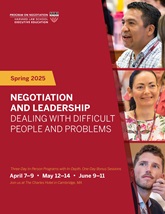
In our easiest professional negotiations, we have ample resources to divide among us, and everyone involved expects to benefit in both the short term and the long term from a deal. Unfortunately, there are also times when reaching common ground would require significant sacrifices from everyone involved. The temptation in such situations is to stonewall and put off negotiations for as long as possible.
That’s why the new climate accord announced by the United States and China on November 12 came as such a surprise. For many years, the world’s top two carbon polluters—jointly responsible for an estimated 42% of global greenhouse gas emissions—were deadlocked over who was more to blame for climate change and, consequently, who bore greater responsibility for addressing it. The bickering was exacerbated by ongoing distrust between the two nations’ leaders and the knowledge that real efforts to address climate change would be expensive and onerous. The result was a “You go first” attitude that repeatedly brought global climate talks to a standstill.
The new agreement, reached during a conference of Pacific Rim economies in Beijing, includes promises from U.S. president Barack Obama that the United States will emit 26–28% less carbon in 2025 than it did in 2005. Chinese president Xi Jinping, for his part, pledged that China would reach its peak carbon emissions by 2030—an ambitious target—and then begin reducing them through greater reliance on “clean energy” sources, the New York Times reports. Although many climate experts believe the targets don’t go far enough toward heading off a large-scale transformation of the earth’s ecosystem, the bilateral accord is raising optimism that a significant global agreement will be reached at the U.N. climate change conference in Paris at the end of this year.
The unexpected breakthrough between Obama and Xi offers lessons to business negotiators seeking to reach agreement when trust is low and win-win solutions seem elusive.
Moving beyond blame
For years, China was defiant in the face of international pressure to curb its mounting carbon emissions. The United States and other Western nations, whose heavy burning of fossil fuels dates back to the Industrial Revolution, are widely considered the primary culprits behind climate change. Consequently, China long argued that it bore no responsibility for confronting the problem.
Meanwhile, the United States often was perceived as trying to avoid responsibility for dealing with the costly issue by blaming China, India, and other rapidly developing countries for their reliance on fossil fuels. The U.S. Congress has long held the United States back from making significant pledges to carbon reduction on the global stage.
In negotiation, parties typically can choose from various fairness arguments to justify their claims, a tactic that may stall talks indefinitely. The mutual finger-pointing had the convenient effect of delaying action, even as most climate scientists warned that global warming could trigger widespread environmental disaster within decades.
In 2009, a decade of on-and-off negotiations between U.S. and Chinese officials on climate change appeared to crumble when then Chinese premier Wen Jiabao chose to skip a scheduled meeting with Obama and other world leaders at the global climate summit in Copenhagen.
Reasons for a reset
Several factors persuaded the United States and China to press the reset button on climate talks in 2014, writes Jeff Goodell in a Rolling Stone article published in September, before the accord was reached. First, with droughts, floods, and massive storms devastating regions across the globe, it was becoming increasingly difficult for leaders to deny or downplay the destructive impact of climate change and the dire predictions of climate scientists.
Second, in 2012, as he made climate change a central focus of his second term, Obama began undertaking domestic initiatives, such as a plan to cut carbon dioxide emissions from power plants, to show that he wouldn’t just hold other nations responsible for cutting greenhouse gas emissions. His efforts were aided by falling prices for natural gas, which began to displace coal, leading to declines in U.S. carbon emissions. China, meanwhile, demonstrated similar goodwill by setting targets for pollution control, opening solar and wind plants, and introducing domestic carbon-trading initiatives.
Third, China and the United States began engaging in tentative “trust-building exercises,” such as agreements to collaborate on developing technologies to reduce reliance on carbon, according to the Guardian. In 2013, Obama and Xi negotiated a deal to phase out HFCs, or hydrofluorocarbons, potent greenhouse gases used in air conditioners and refrigerators. As other industrialized nations came on board with the plan, the two presidents began to understand that they had extraordinary power to lead a global accord by working together.
Fourth, China’s exponentially growing energy demands gave it strong incentives to replace finite natural resources such as oil, coal, and gas with cleaner alternative-energy sources such as wind and solar power. With air pollution contributing to 1.2 million premature deaths in 2010 in China, the country’s leaders were motivated to declare “war” on pollution, in the words of the Chinese premier. China also faced intense international pressure to behave responsibly.
Fifth, climate change was viewed as a relatively noncontroversial issue on which to improve Sino-American relations. Dealings between the nations have been frosty because of China’s investments in long-range missiles and Chinese perceptions that Obama is trying to “contain” China through an increased military presence in the region.
Nine months of warming
The recently unveiled climate accord, nine months in the making, was prompted by a February 2014 visit to Beijing by U.S. secretary of state John Kerry, writes Suzanne Goldenberg in the Guardian. After Chinese officials appeared receptive to Kerry’s request to reopen talks, Obama followed up with a personal letter to Xi suggesting that the two nations begin to move together to cut carbon pollution.
A round of diplomatic meetings followed. At a United Nations climate summit in New York in September, Chinese vice-premier Zhang Gaoli, who oversees climate and energy, told Obama that China was not yet prepared to announce a date for peaking its carbon emissions. However, he said China wanted to move quickly on a bilateral climate deal during Obama’s upcoming visit to Beijing.
Obama quickly dispatched a U.S. delegation to China that included Kerry, U.S. energy secretary Ernest Moniz, and Obama’s point person on climate policy, John Podesta. It was “the diplomatic equivalent of a full-court press,” according to Rolling Stone.
As Obama headed to Beijing for the Pacific Rim conference in early November, officials were refining the language of their agreement, a process that reportedly went “down to the wire,” the Guardian writes. Over two days of meetings, Obama and Xi finalized the agreement and reached separate accords aimed at calming military tensions off the Chinese coast and cutting tariffs for technology products.
A tense coda
President Obama and President Xi’s November 12 press conference to announce their deals on climate change and other issues threw a “dash of cold water” on the idea that the two nations were entering a new era of cooperation and harmony, China expert Orville Schell of the Asia Society in New York City told the New York Times. Having been pressured by the White House to take questions from both domestic and foreign media, Xi delivered a lecture that included a warning to foreign governments that might consider getting involved in the pro-democracy movement in Hong Kong. The moment illustrated that the “happy talk of win-win solutions masks a ferocious rivalry,” writes Mark Landler in the Times. It also contributed to the perception that Obama and Xi’s relationship is based more on pragmatism than personal warmth. Overall, it served as a reminder that negotiation breakthroughs don’t completely resolve tense situations, but rather move parties on to the next challenge.
From “You go first” to “Let’s go”
Whether the climate accord will hold and how much influence it will have remain to be seen. Though the current agreement does not require congressional approval, Congress could take steps to roll back the initiatives. Moreover, the unwieldy nature of U.N. climate summits could complicate broader adoption of the accord’s principles. Finally, some experts have argued that the plan doesn’t go far enough to avert potential climate-related disasters.
Overall, though, the agreement stands as a reminder that in negotiation, the tools we need to overcome mutual distrust and accept responsibility for a shared burden are typically within our grasp. Here are five takeaways from the talks:
1. Agree to disagree. You may never know who caused a shared problem. Rather than arguing about who’s to blame, encourage a focus on finding solutions.
2. Capitalize on changing conditions. Your relationship may seem stuck, but the world around you isn’t. Pay attention to changes in your broader environment, as you may be able to draw on them to motivate discussions.
3. Narrow the playing field. If multiparty negotiations become fractious and chaotic, try forging a bilateral partnership and then bringing other teams on board later.
4. Prove you’re trustworthy. To overcome perceptions that you’re unreliable, take concrete actions that demonstrate you are willing to invest resources to improve the status quo.
5. Start small. Try testing the waters and establishing trust by negotiating minor deals before tackling more difficult ones.



